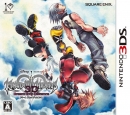The Nintendrone: Can Microsoft and Sony Compete With The Wii U?
Since the Wii U’s announcement, we’ve been hearing the same things time and time again. We’ve heard about how the Wii U is doomed, we’ve heard how it won’t be able to compete with current hardware, and we’ve heard about how it will be blown out of the water by the inevitable PS4 and Xbox 720. How exactly can the Wii U compete with Sony and Microsoft’s next-gen offerings? Here’s a better question. How can Sony and Microsoft compete with the Wii U?
The Wii Won This Generation
The past year has been a rough one for the Wii. Nintendo’s dominance over the home console market has been dwindling. For the past year, Nintendo has been routinely beaten by both Sony and Microsoft. In comparison, Nintendo was going head to head with its competitors in 2011 and destroying them in 2010. Pundits, Sony fans, and Microsoft fans have been waiting for this. They’ve been waiting for the moment where they could finally say, “We told you so. The Wii was a fad.”
Let’s take a moment to put things in perspective. The Wii currently enjoys 41.9% of the home console market and has sold just about 30 million more units than either of its competitors. At the current weekly rate that the consoles are selling, it will take the Playstation 3 nearly nine and a half years to catch up to the Wii’s hardware sales. It will take the X-Box 360 over a dozen years. In terms of software, the X-Box 360 and PS3 will catch up with the Wii in 16 and 7 years respectively. These numbers don’t take the fluctuations of the gaming market into account, but even so, they show that the Wii has been insanely successful despite its recent struggles.
Why exactly is the Wii slumping? Part of the reason that hardware sales are down is simply due to market saturation. The Wii has sold over 96 million units. That’s just about 30 million more than either of its competitors. There are simply less people out there who don’t own a Wii. Unlike the X-Box 360 and Playstation 3, the Wii hasn’t seen any major hardware revisions and hasn’t seen any major peripherals to stir up excitement. To make things worse for the aging console, Nintendo’s focus is squarely on their upcoming Wii U console and their fledgling new portable, the 3DS. It’s only natural that the Wii is winding down after a long and successful lifespan. The idea that the Wii U won’t be successful because the Wii is having an understandably slow year is silly.
Critics could say that the Wii wouldn’t be cooling off so fast if its hardware were more powerful and it was able to support modern third party games. This is true, and hopefully this fact will teach Nintendo a valuable lesson. However, this doesn’t change the fact that the Wii will undoubtedly go down as the most successful console of its generation.
Diminishing Graphical ReturnsSo far, the history of gaming consoles has been a history of increasing hardware specs. Each successive generation has dazzled gamers with new and incredible graphics. The leap in graphics from the PS2 to the X-Box 360 was accentuated by the advent of HD televisions. Can we expect a similar leap from Sony and Microsoft’s next consoles? No, probably not.
I’m not going to get into speculative specs or anything like that, but I will point you to a video of the Playstation 3, X-Box 360, and PC versions of Battlefield running side by side. It stands to reason that the Playstation 4 will not match high end modern PCs in terms of hardware specs. Making a console that could compete with top of the line PCs would be incredibly expensive. With that in mind, take a look some of the better looking PC games. Expect first generation games on the PS4 or 720 to look similar to those. Compared to the 360 and PS3, we’re going to see sharper textures, smoother frame rates, more active environments, and perhaps more enemies wandering around in some games, but the leap in graphics will be smaller than it has been in previous generations.
To a big gamer, there is a word of difference between PC graphics and console graphics, but will such a leap be enough to convince casual gamers (and by casual I mean both Wii Sports fans and Call of Duty fans) to buy a new console? I don’t think it is. Graphics aren’t going to be a big selling point for next generation consoles.
Scaling Is Your Best Friend
It’s fairly safe to assume the Wii U will be less powerful than its competitors, but that may be less of an issue than it has been due to the way software is being designed. Engines like Unreal 4 and Square’s Luminous engine have been designed with scalability in mind. What this means is that those engines can be run on a wide array of machines including PCs, current gen consoles, iPhones, and presumably next generation consoles. If Luminous will run on an iPhone it will undoubtedly run on theWiiU. This is good news for Nintendo as it ensures that ports to the Wii U will be relatively easy.
Can Microsoft and Sony Capture The Casuals?
We always hear questions on whether or not Nintendo can capture the hardcore audience. It’s easy to understand why that question is tossed about so much on gaming websites because most of our readers are hardcore gamers. In terms of financial success however, courting casual gamers is just as important as capturing the hardcore. Nintendo has shown a consistent ability to create products that appeal to the masses, and I expect this trend to continue in the next generation. Can Sony and Microsoft steal Nintendo’s casual thunder?
Can Sony thrive in the casual market? It looks unlikely. Sony’s push into the casual market was the Playstation Move, and that was a complete disaster. It’s hard to gauge the Move’s sales, because accessory sales figures are hard to come by. However, software numbers paint a clear picture. Just Dance 3 sold 9.6 million units on the Wii, and is still selling well. On the Kinect, the series moved a more modest but still respectable 1.8 million. On the Playstation 3? Under half a million. Move Heroes has sold about 100,000 copies, and Sorcery, which Sony said would <a href=”http://www.destructoid.com/sony-sorcery-shows-why-move-is-better-than-wii-kinect-218027.phtml> prove that the Move was better than the Kinect or Wii</a>, has sold under 100,000 units so far. Ouch ouch ouch
Sony doesn’t seem to have a strong grasp on what casual fans are looking for. Sony has focused on creating pale imitations of motion based success stories. Carnival Games was successful, so Sony created Carnival Island. Just Dance begot Everybody Dance. Wii Sports begot Sports Champions. Sony’s more original efforts, Sorcery and Medieval Moves, simply didn’t strike a chord with casual or hardcore gamers. It’s hard to see Sony suddenly making a console with Wii-like appeal next time.
Microsoft has had more success with the Kinect. The Kinect had an incredibly hot start with 8 million units sold in just 60 days. Since those first 60 days, Microsoft has only managed to push out another 9 million units, bringing the total to 17 million. In terms of software, the Kinect had some early hits with Kinect Sports, Dance Central, Kinectimals, and Kinect Joy Ride, which sold largely based on the momentum of the hardware. Since then, success stories on the Kinect have been hard to come by. Dance Central 2 and Kinect Sports 2 sold well, but like most sequels, they failed to match their predecessors. Aside from that, Just Dance 3 is the only game that’s really performed well for the Kinect.
Is the Kinect a failure? That depends on how you evaluate it. As a peripheral, it has been one of the most successful peripherals of all time, and it probably earned Microsoft a nice chunk of change. In terms of breaking into Nintendo’s market, the Kinect hasn’t been very successful. Nintendo’s 6 year old machine is outselling Microsoft’s fresh faced add on, by just under a million units this year according to VGChartz.com, and Kinect software support is growing thin. As a true competitor to the Wii, the Kinect has failed.
One can argue that the Kinect was merely meant as a means to change Microsoft’s image in the gaming world. Just like how the X-Box lost money but established Microsoft as a force in the gaming world, perhaps the Kinect was meant to establish the X-Box line as a family friendly product. This is possible, but I think many casual gamers feel burned by the Kinect. They plunked down 300 dollars or more for a family friendly experience and the console they purchased lacked compelling software.
All indicators point to a new Kinect being included with the X-Box 720, but I’m not sure what such a peripheral would offer. The main problem with Kinect isn’t its accuracy, but its general concept. The Kinect is a good fit for a small number of genres. It’s great for Dance games and it has great applications for minigame collections. Aside from these genres, the Kinect is ill suited to gaming. As much as it may surprise people, dance games and minigame collections aren’t enough to hold casual gamers’ attention. If Microsoft wants to attack Nintendo’s market, the Kinect is not the way to do it.
The Dual Screen Wars Are Over Before They Began
It seems that all three companies are intent on bringing a two screened gaming experience to gamers. Nintendo will be doing so with their Wii U Gamepad, Sony will be doing so with the Vita, and Microsoft will be doing so with their Smartglass software. I’d love to go into a detailed comparison of the technology, but that’s a topic for another column. I will say that Nintendo has the best dual screened solution of the three.
Sony’s Vita/PS3 combo has unique potential considering that the Vita has its own processor, but it’s also the most costly. Low adoption rate of the Vita will make this feature an unattractive prospect for developers and gamers. The Smartglass will essentially be free for any gamer who owns a 360 and a tablet or smartphone. The problem here is that smartphones and tablets are not well suited for console style games. Being able to adjust my plays on the fly in Madden is an appealing concept, but if that means trading in my controller for an iPad, I’m not interested. The Smartglass will further Microsoft’s goal of creating a good multimedia experience, but it will be useless to gamers.
The Wii U solves both these problems. The Gamepad will be packed in with every console, and it is designed with games in mind. Its features can and will be implemented into virtually every game on theWiiU. Based on this factor alone the Wii U will be a better dual screen solution than its competitors.
Can Nintendo Build A Better Network?
One of Nintendo’s most glaring mistakes with the Wii U was its online interface. Sadly, Nintendo’s online functionality failed to meet the standard set by the original X-Box. Thankfully, it seems that Nintendo has taken steps to rectify this. The Miiverse is, in my humble opinion, the single most important factor in the Wii U’s long term success. Selling casual gamers a console is easy. Keeping them playing is a more challenging prospect. The Miiverse looks to solve this problem.
The idea of Miiverse is to turn even single player experiences like Mario into social experience. Making gamers feel as though they are part of a community will keep them playing their Wii U on a regular basis. On a less altruistic note, the Miiverse is a constant advertisement for Wii U games, and it will help spread awareness for titles that may otherwise go unnoticed. I don’t think Miiverse will replace X-Box Live in the hearts of hardcore games, but it will likely provide a more pleasant and accessible experience for newer or casual gamers.
How Can Sony And Microsoft Compete?
Nintendo’s issues last generation were obvious. Their online interface wasn’t up to snuff, and their hardware support was lacking. Assuming that Nintendo isn’t run by chimps, they’ll be able to correct these problems fairly easily. If the hardware is able to run third party games, third parties will develop for it, and the Miiverse already looks like a vast improvement over the Wii’s online network.
On the other hand, Nintendo’s success will be hard for Microsoft or Sony to replicate. While many elitists think that it’s easy to make games that appeal to a casual market, it’s actually quite difficult to create something that resonates with the masses for an extended period of time. Microsoft and Sony each have a strong following among hardcore gamers, but neither company has been able to gain any lasting traction in the casual market.
This begs the question of this article; how can Microsoft and Sony compete with Nintendo? If the Wii U sees the same multiplatform games as Sony and Microsoft, and offers a compelling online network, what will Sony and Microsoft’s competitive advantage be? Will graphics on the levels of a current PC be good enough draw in customers? Can Sony and Microsoft create something that resonates with a broad range of consumers? Do Microsoft and Sony have what it takes to break out of the “hardcore” niche where they’ve thrived? It will be interesting to see how Sony and Microsoft answer these questions, but for now, I think that Nintendo is in great competitive shape.
What say you GotGamers? Have I been drinking too much of the mushroom flavored Kool-aid? Will the graphics of the PS4 blow my coin addled mind? Will Miiverse crash and burn? Or will Nintendo indeed lead the hardware market for another generation? I’ve had my say, so have yours in the comments section. Alternatively you could let me know on Twitter @ twitter.com/Nintendrone.
http://gotgame.com/2012/08/25/the-nintendrone-can-microsoft-and-sony-compete-with-the-wii-u/




























































